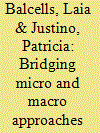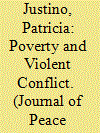|
|
|
Sort Order |
|
|
|
Items / Page
|
|
|
|
|
|
|
| Srl | Item |
| 1 |
ID:
134940


|
|
|
|
|
| Summary/Abstract |
This article reflects on the importance of linking micro and macro levels of analysis in order to advance our current understanding of civil wars and political violence processes and discusses the contributions of the articles in this special issue. We first identify the main problems in research on political violence that is focused on a single level of analysis and describe the challenges faced by research that attempts to establish connections between different levels. We then introduce the different articles in the special issue, with an emphasis on the micro–macro-level linkages they develop and highlighting their commonalities. We conclude by emphasizing the importance of a new research agenda for the study of civil wars and political violence that bridges social, economic, and political dynamics occurring at the local level and conflict processes taking place in the macro arena.
|
|
|
|
|
|
|
|
|
|
|
|
|
|
|
|
| 2 |
ID:
134944


|
|
|
|
|
| Summary/Abstract |
This article analyzes the determinants of household riot victimization, based on a unique survey collected in Maharashtra, India. We adopt a multilevel framework that allows neighborhood and district effects to randomly influence household victimization. We find that economically vulnerable households, households living close to unsafe areas, and shop owners are more prone to suffer from riots. Households report lower levels of victimization if they live further from police stations, exhibit higher levels of trust, are able to rely on outside help in times of need and accumulate savings. The results show, however, a double-edge effect of income: wealthier households are better able to cope with the adverse effects of riots, but also have more to lose from riots and are more exposed to opportunistic violence and looting. We find further that affluent neighborhoods and neighborhoods where caste fragmentation is high report higher levels of victimization. Neighborhoods with stronger social interactions experience lower levels of victimization.
|
|
|
|
|
|
|
|
|
|
|
|
|
|
|
|
| 3 |
ID:
088353


|
|
|
|
|
| Publication |
2009.
|
| Summary/Abstract |
This article discusses how endogenous mechanisms linking processes of violent conflict and the economic well-being of individuals and households in combat areas provide valuable micro foundations to the ongoing debate on the causes and duration of armed conflict. Notably, the endogenous relationship between conflict processes and household economic status leads to the emergence of symbiotic associations between armed groups and households living in areas they control that affect substantially the probability of a conflict starting and its effectiveness thereafter. Households in conflict areas draw on local armed groups to protect their economic status when anticipating violence and during the conflict, while armed groups make use of different levels of (either reluctant or voluntary) participation, support and cooperation from local populations to advance their strategic objectives at the onset and throughout the conflict. The level of household participation at the start and during the conflict is a function of two interdependent variables, namely household vulnerability to poverty and household vulnerability to violence. The poorer the household is at the start of the conflict, the higher is the probability of the household participating and supporting an armed group. The higher the risk of violence, the higher is the probability of the household participating and supporting armed groups. The interaction between these two variables varies with the conflict itself and is defined by the direct and indirect effects of conflict-induced violence on the economic behaviour and decisions of households in combat areas.
|
|
|
|
|
|
|
|
|
|
|
|
|
|
|
|
| 4 |
ID:
169074


|
|
|
|
|
| Summary/Abstract |
This article analyzes the role of individual redistributive preferences on protest participation. The article focuses on Latin America, a region that has experienced substantial protests and demonstrations in the last decade, making use of individual-level data on redistributive preferences and protest participation collected across eighteen countries in 2010, 2012, and 2014. The results show evidence for an association between strong individual preferences for redistribution and participation in protests motivated by the low quality of services and institutions, failures to reduce corruption, and perceived lower standards of living. The results are robust to alternative estimators, samples, and model specifications and not affected by endogeneity concerns.
|
|
|
|
|
|
|
|
|
|
|
|
|
|
|
|
|
|
|
|
|